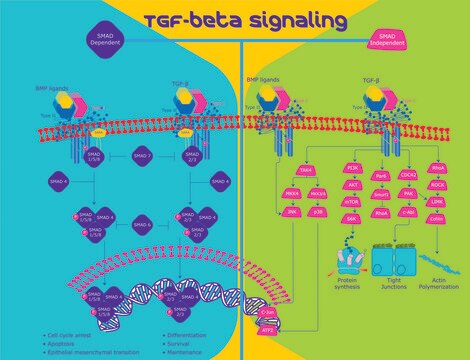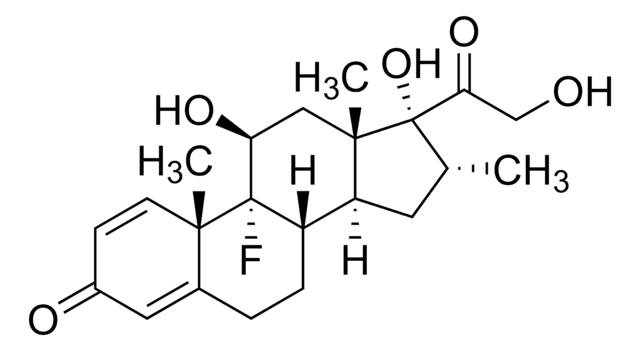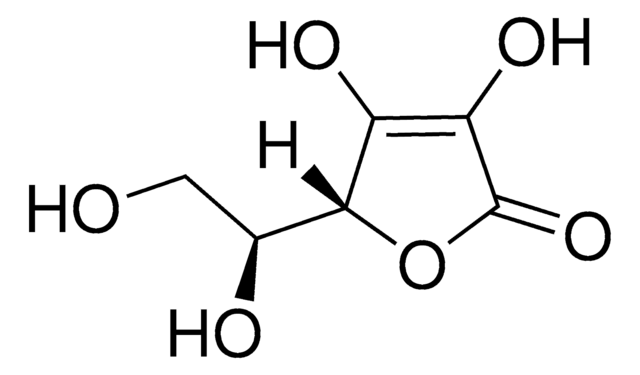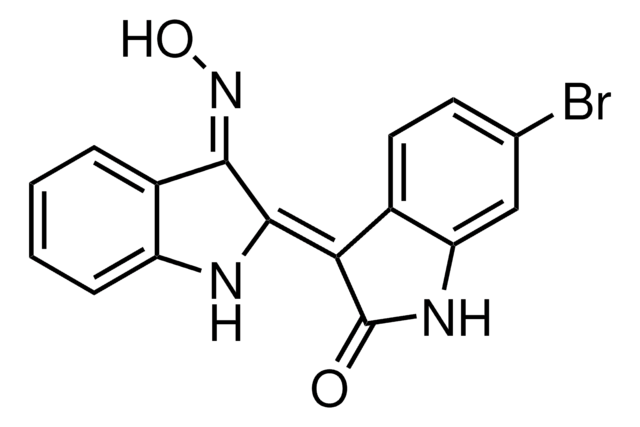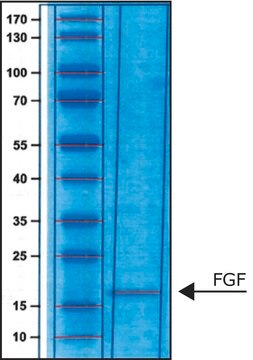SRP3326
BMP-2 human
Animal-component free, recombinant, expressed in E. coli, ≥98% (SDS-PAGE), ≥98% (HPLC)
Synonym(s):
BMP-2A
Sign Into View Organizational & Contract Pricing
All Photos(1)
About This Item
UNSPSC Code:
12352202
NACRES:
NA.32
Recommended Products
Related Categories
General description
The functional form of BMP-2 (bone morphogenetic protein 2) is a 26kDa protein composed of two identical 114 amino-acid polypeptide chains (monomers) linked by a single disulfide bond. Each BMP-2 monomer is expressed as the C-terminal part of a precursor polypeptide, which also contains a 23 amino-acid signal sequence for secretion, and a 259 amino-acid propeptide. After dimerization of this precursor, the covalent bonds between the propeptide (which is also a disulfide-linked homodimer) and the mature BMP-2 ligand are cleaved by a furin-type protease. Recombinant human BMP-2 is a 26kDa homodimeric disulfide-linked protein consisting of two identical 115 amino acid chains.
Application
BMP-2 human has been used to study the biological role of BMP-2 on adult renal progenitor cells under in vitro and in vivo conditions.
Biochem/physiol Actions
BMP-2 (bone morphogenetic protein 2) is a potent osteoinductive cytokine, capable of inducing bone and cartilage formation in association with an osteoconductive carrier such as collagen and synthetic hydroxyapatite. During bone repair, it controls the expression of Runt-related transcription factor 2 (Runx2) and Osterix (Osx), thereby enhancing migration, proliferation and osteogenic differentiation of mesenchymal stem cells. In addition to its osteogenic activity, BMP-2 appears to play an important role in cardiac morphogenesis, and is expressed in a variety of other tissues including lung, liver, spleen, prostate, ovary, and small intestine.
Physical form
Lyophilized from 0.1% TFA.
Reconstitution
Centrifuge the vial prior to opening. Reconstitute in water to a concentration of 0.1-1.0 mg/ml. Do not vortex. This solution can be stored at 2-8°C for up to 1 week. For extended storage, it is recommended to further dilute in a buffer containing a carrier protein (example 0.1% BSA) and store in working aliquots at -20°C to -80°C.
wgk_germany
WGK 3
flash_point_f
Not applicable
flash_point_c
Not applicable
Certificates of Analysis (COA)
Search for Certificates of Analysis (COA) by entering the products Lot/Batch Number. Lot and Batch Numbers can be found on a product’s label following the words ‘Lot’ or ‘Batch’.
Already Own This Product?
Find documentation for the products that you have recently purchased in the Document Library.
Customers Also Viewed
Bone regeneration with low dose BMP-2 amplified by biomimetic supramolecular nanofibers within collagen scaffolds.
Lee SS, et al.
Biomaterials, 34, 452-459 (2013)
A role for bone morphogenetic proteins in the induction of cardiac myogenesis.
Schultheiss TM, et al.
Genes & Development, 11, 451-462 (1997)
Bone morphogenetic proteins: multifunctional regulators of vertebrate development.
Hogan BL
Genes & Development, 10, 1580-1594 (1996)
Vera Hintze et al.
Biomacromolecules, 15(8), 3083-3092 (2014-07-17)
Sulfated glycosaminoglycans (GAGs) can direct cellular processes by interacting with proteins of the extracellular matrix (ECM). In this study we characterize the interaction profiles of chemically sulfated hyaluronan (HA) and chondroitin sulfate (CS) derivatives with bone morphogenetic protein-2 (BMP-2) and
Rick Visser et al.
Tissue engineering. Part A, 20(1-2), 34-44 (2013-07-19)
Osteogenesis is a complex, multifactorial process in which many different signals interact. The bone morphogenetic proteins (BMPs) are the most potent inducers of osteoblastic differentiation, although very high doses of BMPs in combination with collagen type I formulations have to
Our team of scientists has experience in all areas of research including Life Science, Material Science, Chemical Synthesis, Chromatography, Analytical and many others.
Contact Technical Service